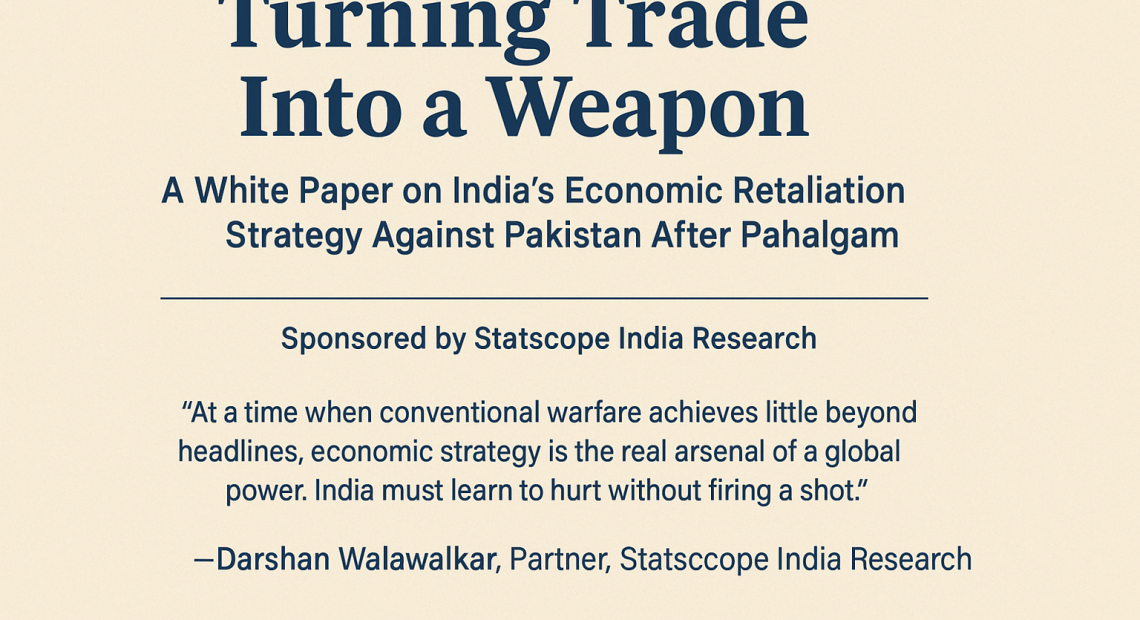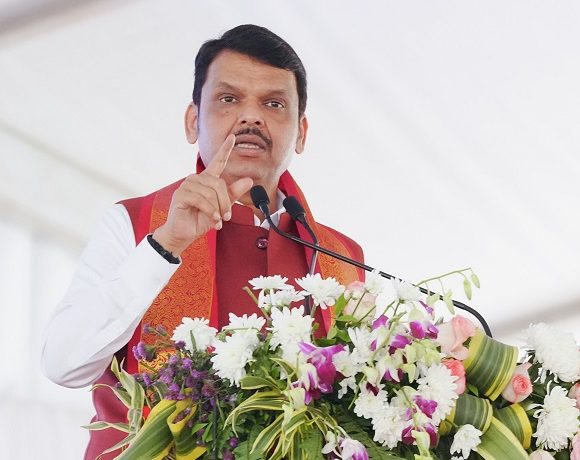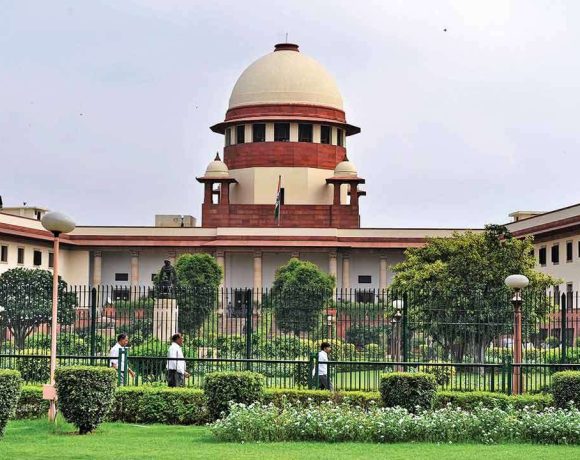
Turning Trade Into a Weapon: A White Paper on India’s Economic Retaliation Strategy Against Pakistan After Pahalgam | Statscope India
Sponsored by Statscope India Research
Introduction
The frequency and audacity of cross-border terrorist attacks on Indian soil have forced the country to confront a difficult truth — the traditional tools of retaliation are no longer enough. Despite multiple military responses, international appeals, and diplomatic warnings, Pakistan continues to shelter, support, and finance extremist networks that target India with impunity. The Pahalgam attack of April 2025 marks a grim reminder that tactical airstrikes and diplomatic protests do not change strategic behavior. It is in this context that India must evolve its doctrine of response. This white paper proposes a bold alternative: the use of India’s economic strength as an instrument of national security. Rather than meet blood with bombs, India must now hurt where it matters most — the economic foundations that sustain Pakistan’s ability to sponsor terror. Through trade leverage, financial isolation, corporate access policy, and global narrative control, India has the means to impose real, lasting consequences. This is not about escalation. It is about evolution.
1. Contextual Background: Why the Pahalgam Attack Is a Strategic Inflection Point
The Pahalgam terror attack in April 2025 has once again brought to the fore the persistent and calculated threat emanating from across the border. This was not an isolated incident but part of a familiar pattern where non-state actors, backed by Pakistan’s military-intelligence nexus, carry out brutal assaults on Indian soil. Over the years, attacks in Uri, Pulwama, and Pathankot have followed a similar trajectory—planned in Pakistan, executed in India, and then denied with a straight face by Islamabad. Pahalgam represents a continuity of this state-sponsored strategy of bleeding India without crossing into formal war.
What makes Pahalgam different, however, is the growing geopolitical vacuum around Pakistan. In previous incidents, Pakistan could rely on a mix of Western diplomatic deflection, Gulf economic support, and Chinese vetoes. Today, that support base is eroding. China, while still a vocal backer, is under increasing global scrutiny for its own international behavior, and most Western countries no longer see Pakistan as an indispensable counterterrorism partner.
The Indian public has reacted with expected anger. But unlike earlier times, there is a noticeable shift in tone among policymakers and diplomats. There is a growing realization that military strikes, while symbolically satisfying, have failed to deter Pakistan’s strategic use of terrorism. Surgical strikes post-Uri, airstrikes post-Pulwama, and covert operations have all delivered tactical blows. But the strategic calculus in Rawalpindi remains unchanged. The reason is simple: Pakistan absorbs military losses far more easily than economic ones.
This white paper is born out of that strategic shift. It argues that India must move beyond the binary of peace talks and border skirmishes. Instead, it must begin using its economic weight as a weapon. The global order increasingly rewards economic diplomacy and punishes belligerence through trade restrictions and market exclusions. India, with its enormous market, growing FDI, and strategic alliances, has far more power than it chooses to wield.
Pahalgam must not just be another funeral followed by hollow warnings. It must be remembered as the moment India decided to rewrite the rules of retaliation.
2. Pakistan’s Economic Fragility: A Tactical Opportunity
Pakistan’s economy today is on the brink of collapse. The country is gripped by an unprecedented financial crisis marked by rising inflation, falling currency value, plummeting foreign exchange reserves, and a massive debt burden. For India, this is not merely a sign of a failed state next door. It presents a strategic opportunity to exert non-military pressure in ways that could yield long-term deterrence.
Pakistan’s foreign exchange reserves have hovered dangerously below 4 billion dollars in recent months, barely enough to cover a few weeks of imports. Inflation has crossed 35 percent, and the rupee has fallen sharply against the dollar. Amidst this instability, the country has repeatedly approached the International Monetary Fund and friendly nations like Saudi Arabia and the United Arab Emirates for bailouts. Even China, its so-called “iron brother,” has been reluctant to offer unconditional aid, demanding stricter terms and guaranteed returns on its investments under the China-Pakistan Economic Corridor.
The government in Islamabad has no coherent long-term economic vision. Structural reforms are absent, foreign direct investment is minimal, and exports have stagnated due to energy shortages, a crumbling infrastructure, and domestic unrest. The textile industry, which forms the backbone of Pakistan’s export economy, is losing global contracts due to power outages and increasing costs. At the same time, widespread corruption, political instability, and extremist violence continue to drive businesses away.
More importantly, Pakistan’s reliance on China has made it vulnerable. Chinese loans come with high-interest rates and steep repayment obligations, pushing Pakistan further into debt dependency. Unlike Western lenders, China offers no transparency, no grace periods, and no real restructuring support. Its Belt and Road investments are driven not by charity but by geopolitical leverage. Beijing’s interests are aligned with its own long-term strategic goals, not with saving Pakistan from economic ruin.
This economic fragility opens a window for India. Unlike in the past, where global players might have rushed to stabilize Pakistan for fear of regional instability, the current world order is less sympathetic. The West is disillusioned, the Gulf is cautious, and China is self-serving. India must recognize this moment and shift its strategy from reactive military posturing to proactive economic coercion. By tightening diplomatic noose, blocking market access, and framing global narratives, India can force Pakistan to pay a tangible price for its support to terror.
The key lies not in seeking collapse, but in controlling the pressure valve—slowly and deliberately—until Rawalpindi begins to weigh the economic cost of every terrorist it harbors.
3. India’s Economic Arsenal: Tools to Strike Back
India has for long underused one of its most potent instruments of power — its economy. With a GDP exceeding 3.7 trillion dollars, a consumer market of over 1.4 billion people, and rising foreign investment, India holds significant economic leverage in the global system. This leverage can be turned into a tool of deterrence if strategically directed at Pakistan through targeted policies and global coordination. Unlike military operations that carry the risk of escalation and limited duration, economic pressure offers a sustained and legally acceptable method of punishment.
3.1 Trade Leverage
India had already suspended most bilateral trade with Pakistan following the Pulwama attack in 2019. However, trade still occurs indirectly through third countries such as the United Arab Emirates and Singapore. These loopholes must be identified and systematically closed. New customs protocols and intelligence-backed scrutiny can disrupt such indirect flows. India can also promote a South Asia-wide anti-terror trade framework that discourages regional trade with countries found harboring terror groups.
At the multilateral level, India can campaign to have Pakistan excluded from preferential trade arrangements by the European Union and other major blocs. This will hit Pakistan’s textile and leather export sectors hard, which are heavily dependent on GSP (Generalised Scheme of Preferences) privileges.
3.2 Corporate Access Doctrine
A more assertive approach would be to implement a corporate access doctrine: companies that want full access to India’s massive consumer and industrial market must not maintain operations, partnerships, or significant investments in Pakistan. This policy need not be declared as an outright ban. Instead, it can be woven into national security clauses, compliance frameworks, or tax policies.
Sensitive sectors such as defense technology, digital payments, telecom infrastructure, pharmaceuticals, and cloud services can be the first to face these restrictions. Over time, even FMCG giants, logistics firms, and tech platforms can be brought under this policy. The message would be clear — global businesses must choose. Between a stable, growing economy like India and a volatile, terror-linked Pakistan, the choice is obvious.
3.3 Investment Embargoes
India should also consider introducing a conditional FDI framework where companies with financial stakes or subsidiaries in Pakistan are either denied entry or subjected to enhanced regulatory scrutiny. Strategic sectors such as aerospace, semiconductors, ports, and infrastructure should be declared off-limits to companies working with Pakistan. Simultaneously, India can push partner nations to adopt similar guidelines, especially members of the Quad and key EU trade partners.
India must also actively engage with sovereign wealth funds, especially from the Gulf, to discourage large investments into Pakistan without transparency and accountability. If Indian investment flows and market size are seen as contingent upon responsible global capital behavior, it would be difficult for Pakistan to attract the funds it needs to stay afloat.
3.4 Water Diplomacy
Another underused tool in India’s economic arsenal is water. While India has respected the Indus Waters Treaty since its signing in 1960, it can begin to assert its full rights over the eastern rivers, especially the Ravi and Beas. Dams, barrages, and hydropower projects that are legally permitted under the treaty should be expedited. These developments would reduce the water flow to Pakistan marginally but symbolically signal that India is no longer willing to subsidize the very country that funds its enemies.
3.5 Multilateral Financial Pressure
India should utilize its growing influence in international forums to prevent Pakistan from receiving unconditional financial aid. At the International Monetary Fund, World Bank, and Asian Development Bank, India must push for stricter conditionalities tied to anti-terror compliance. Simultaneously, India can share intelligence on terror financing networks based in Pakistan with financial regulators and watchdogs like FATF to keep Islamabad under sustained scrutiny.
Coordinated lobbying with allies like the United States, France, UAE, and Australia can create a broader coalition that denies Pakistan easy access to global capital markets. Once Islamabad realizes that financing terror means shutting its doors to survival funding, the incentives for harboring militants will diminish.
4. Strategic Communication and Narrative Warfare
In today’s interconnected world, wars are not only fought with weapons or sanctions but with narratives. Pakistan has long benefited from portraying itself as a victim of global conflicts, a frontline state in the war on terror, or a helpless country trapped between India and Afghanistan. These carefully crafted images have helped Pakistan win sympathy, secure funding, and deflect accountability. It is time India challenged and dismantled this narrative on the global stage.
Strategic communication begins with truth, but it requires repetition, amplification, and platforms. India must consistently highlight Pakistan’s duplicity — a nation that seeks global aid to fight terror while simultaneously protecting and nurturing the very infrastructure that breeds it. The Pahalgam attack is not just a terror strike; it is a signal to the world that Pakistan remains an enabler of extremist violence. India must ensure that this truth is heard in every global capital, newsroom, and multilateral summit.
One of the most effective tools in narrative warfare is documentation. India should publicly release intelligence-backed dossiers detailing the role of Pakistan’s military and intelligence agencies in coordinating terror plots. These should include names, communication records, financial transfers, and satellite imagery when available. Making such data public disarms deniability and forces neutral observers to confront reality.
Media diplomacy must be ramped up. Indian diplomats, retired military officials, and strategic thinkers should regularly write in foreign newspapers, appear on global news channels, and participate in policy forums to reinforce India’s position. Social media campaigns must target global audiences, using multilingual content, infographics, and human stories of terror victims to generate empathy and awareness.
Another important front is international legal pressure. India can push for individual sanctions, visa bans, and asset freezes against known Pakistani terror enablers. These sanctions should be pursued in coordination with countries like the United States, the United Kingdom, and European Union members. Even if only a few countries comply, the signal sent to global financial networks and multinational businesses will be powerful.
At the United Nations, India should renew its campaign to designate specific individuals and organizations operating from Pakistani soil as global terrorists. Simultaneously, it must lobby against Chinese vetoes on such resolutions by mobilizing broader diplomatic coalitions and public opinion.
Finally, India must work closely with nations like Israel, France, and Australia to develop a shared doctrine on state-sponsored terror. This will create a common vocabulary and policy template that can be deployed against countries like Pakistan when they cross the threshold of tolerable state behavior.
Narrative warfare is not about shouting louder, but about exposing truths that others are trying to bury. By owning the narrative and controlling the global conversation, India can turn the moral tide decisively in its favor and ensure that Pakistan pays a reputational cost every time it aids terror.
5. Cost-Benefit Analysis of Economic Retaliation vs. Military Strike
For decades, India’s primary response to major terror attacks from across the border has oscillated between diplomatic protests and limited military operations. Surgical strikes, air raids, and covert actions have their place in national defense, and they have often provided short-term tactical satisfaction. But over time, it has become clear that such actions neither dismantle Pakistan’s terror infrastructure nor alter its strategic calculus. The costs are high, the gains are temporary, and the global fallout is unpredictable.
On the other hand, economic retaliation offers a more durable and strategic form of pressure. Unlike military operations that invite international scrutiny and risk escalation, economic tools can be calibrated, extended, and deployed with global legitimacy. A cost-benefit analysis shows that in the current geopolitical environment, economic retaliation yields higher dividends with far fewer risks.
Military strikes, such as the 2016 Uri-based surgical operation and the 2019 Balakot airstrike, managed to neutralize specific terror launchpads. However, Pakistan quickly replenished these assets, and within months, new incidents followed. The state structure in Pakistan is built to absorb such limited losses. The military controls not just defense but large sections of the economy, and it uses terrorism as a strategic tool knowing that India’s responses are largely episodic.
Moreover, military action often carries unintended consequences. Any escalation along the Line of Control risks civilian casualties, troop deployments, and disruption of border economies. It also creates a media frenzy that Pakistan leverages to internationalize the Kashmir issue and rally support from its traditional backers, even if temporarily.
In contrast, economic retaliation strikes at the very roots of Pakistan’s survival. A decline in exports, reduced foreign investment, capital flight, and a downgrade in credit ratings have long-term consequences that cannot be reversed overnight. Economic pressure can disrupt the patronage networks that fund extremism, reduce the ability of the military to maintain public legitimacy, and force the civilian leadership to seek course correction.
India also stands to gain economically by taking the moral high ground. Demonstrating that it uses financial instruments, not just firepower, to respond to threats will enhance India’s global image as a responsible power. This would likely attract greater support from developed countries, global corporations, and strategic investors who prefer stability and rule-based engagement.
Furthermore, military strikes are a one-time event, while economic measures can be layered over time. Tariff barriers, FDI restrictions, trade sanctions, and market access denial can be increased or relaxed based on Pakistan’s behavior, creating a structure of conditional engagement. This gives India the ability to control the tempo of retaliation without committing to irreversible escalation.
In summary, while military options should never be taken off the table, it is the economic route that offers India a sustainable, controlled, and globally legitimate method to punish Pakistan. The costs are lower, the risks are manageable, and the impact is potentially transformative.
6. Case Studies
To understand the power of economic statecraft, it is essential to examine how other nations have used economic tools to achieve strategic objectives without direct military engagement. These examples demonstrate that, when applied with consistency and coordination, economic pressure can be as effective—if not more—as kinetic warfare in altering state behavior.
Case Study 1: China’s Economic Coercion of Lithuania
In 2021, Lithuania allowed Taiwan to open a representative office in its capital under the name “Taiwan” rather than “Taipei.” This symbolic move triggered immediate economic retaliation from China. Beijing blocked all Lithuanian imports and pressured multinational companies to sever ties with Lithuanian suppliers. Though the European Union stepped in to support Lithuania, the episode showcased China’s willingness and capacity to use trade as a political weapon.
The result was significant supply chain disruptions and financial pressure on Lithuanian firms. However, it also exposed China’s coercive playbook and drew global criticism. For India, the takeaway is twofold: targeted economic coercion can create real pain, but it must be backed by alliances and counterweights to avoid reputational damage or diplomatic backlash.
Case Study 2: U.S. Sanctions on Iran
The United States has, over the years, perfected the use of economic sanctions to cripple adversarial regimes. The sanctions imposed on Iran since 2018 under the “maximum pressure” campaign targeted oil exports, banking, shipping, and foreign investment. These measures pushed Iran’s economy into recession, slashed its oil revenues, and devalued its currency.
Despite continued defiance by Tehran, the sanctions significantly weakened the state’s capacity to finance proxy militias and its nuclear program. The lesson for India is that when economic measures are multidimensional and backed by international financial systems, they can isolate even energy-rich, militarized regimes.
Case Study 3: Russia’s Economic Strangulation Post-Ukraine Invasion
After Russia’s full-scale invasion of Ukraine in 2022, the West imposed massive sanctions that included cutting Russian banks off from SWIFT, freezing central bank assets, banning technology exports, and slapping embargoes on energy. Although Russia found some short-term workarounds, the long-term impact on its economy has been substantial. Investment plummeted, the ruble fluctuated wildly, and inflation surged.
This case illustrates that even major economies are vulnerable to coordinated economic isolation. While India may not be in a position to unilaterally impose global sanctions, it can work with regional and strategic partners to replicate this approach on a smaller, more targeted scale against Pakistan.
Case Study 4: Saudi Arabia’s Investment Diplomacy
Saudi Arabia has used its sovereign wealth funds as tools of soft coercion. In 2017, it pressured Pakistan to return a 1 billion dollar loan early and suspended a major oil credit facility due to Islamabad’s stance on Kashmir. These moves forced Pakistan to turn to China for emergency funds. The episode highlighted the financial vulnerability of Pakistan and how even temporary withdrawal of economic support can trigger diplomatic re-alignments.
For India, this demonstrates the effectiveness of leveraging relationships with Gulf countries to curtail Pakistan’s financial options.
These case studies show that economic retaliation is not a theoretical concept but a proven strategy. India has the opportunity to tailor these lessons into a uniquely Indian doctrine of economic deterrence that fits its geopolitical context and strategic interests.
7. Roadmap for Implementation
For India to effectively deploy its economic arsenal against Pakistan, the strategy must be executed through a phased, coordinated, and policy-driven roadmap. Isolated actions or symbolic gestures will not yield lasting results. What is needed is a structured approach that combines government policy, diplomatic engagement, corporate cooperation, and intelligence inputs into a seamless economic retaliation framework.
Phase 1: Policy Formulation and Legal Framework
The first step is to frame a clear doctrine of economic retaliation under the umbrella of national security. This doctrine must define what types of corporate behavior, trade relations, or investments will trigger restrictions based on a country’s support to terrorism. The Ministry of Finance, Ministry of External Affairs, and Ministry of Commerce must work together to design this framework with inputs from national security agencies and legal experts.
This phase should also include amending relevant FDI guidelines, trade policy documents, and national security laws to allow for enforcement without delays or legal challenges. A cabinet committee or a national task force on economic deterrence can be established to coordinate inter-ministerial implementation.
Phase 2: Intelligence-Driven Mapping of Targets
India must create an exhaustive list of companies, sectors, and countries that maintain significant economic ties with Pakistan, especially those operating in dual-capacity markets like India and Pakistan. This mapping should include corporate ownership patterns, joint ventures, investment flows, and trade dependencies.
The intelligence community, financial regulators, and economic think tanks should jointly maintain a real-time database of these linkages. This will allow India to design specific measures such as tax barriers, market restrictions, or investment denials tailored to those entities.
Phase 3: Diplomatic Groundwork and Alliance Building
Economic coercion is more effective when done in concert with allies. India must begin quiet diplomacy with strategic partners such as the United States, France, Japan, UAE, and Australia to share its intentions and seek their support. These countries can help apply pressure through multilateral forums like the Financial Action Task Force (FATF), G20, and the World Bank.
India should also actively engage with Gulf countries that hold financial leverage over Pakistan. Building consensus for conditional lending and withdrawal of blanket aid can significantly shrink Pakistan’s fiscal breathing room.
Phase 4: Implementation of Economic Tools
With the legal and diplomatic groundwork in place, India can begin to apply pressure in a calibrated fashion. This could involve:
Banning high-risk companies from participating in government tenders if they maintain active operations in Pakistan.
Imposing tariffs or inspection delays on goods that originate from or are routed via Pakistan-linked supply chains.
Restricting banking access to firms dealing with Pakistani counterparts in sensitive sectors.
Announcing new hydropower or dam projects under the Indus Waters Treaty framework.
Initiating tax audits or denial of subsidies for multinationals with Pakistan exposure.
Each of these steps must be presented as part of a broader national security policy to gain public and judicial support.
Phase 5: Public Communication and Global Narrative
India must explain its actions clearly to both domestic and global audiences. Government spokespersons, diplomats, and media strategists must coordinate the narrative. The message should be: India is not attacking Pakistan’s people but is defending its own citizens by financially isolating a state that enables terrorism.
This phase should also include the global release of intelligence dossiers, victim testimonies, and evidence-based reports to win moral legitimacy and blunt any backlash.
8. Risks and Contingencies
Every strategic move, no matter how well calibrated, carries risks. While the economic retaliation model offers India a powerful alternative to military escalation, it is not without challenges. Anticipating these risks and preparing contingencies will be essential to ensure that the policy does not backfire or destabilize other national interests.
Risk 1: Retaliation from Pakistan through Non-State Actors
Pakistan’s most probable response to Indian economic pressure is to intensify asymmetric warfare. This could come in the form of more frequent terror attacks, especially targeting soft targets such as pilgrim convoys, markets, or civilian gatherings. Increased cross-border infiltration, cyberattacks, and even disinformation campaigns could be used to provoke India into a military response.
Contingency: India must simultaneously ramp up its counterterrorism infrastructure, increase surveillance along vulnerable borders, and improve civilian protection protocols. Cyber defense capabilities should be expanded, particularly around critical sectors like banking, energy, and transport.
Risk 2: Global Corporate Backlash
Some multinational companies may resist India’s policy of conditional market access. They may argue that commercial decisions should not be linked to geopolitical stances. There is also a risk that enforcement could be challenged in court or lead to perceptions of protectionism.
Contingency: India must ensure that the policy is implemented in a transparent, rule-based manner. National security clauses must be well-defined, and exceptions clearly laid out. Incentives can be offered to companies that restructure their Pakistan operations in compliance with Indian policy. Legal teams should preemptively vet all regulatory language to withstand judicial scrutiny.
Risk 3: Diplomatic Blowback
Certain countries, especially those that still maintain ties with both India and Pakistan, may view India’s economic doctrine as escalatory. There is a chance that multilateral forums may hesitate to endorse India’s position if it appears too aggressive or unilateral.
Contingency: India must actively engage in parallel diplomacy, explaining that its policy targets terrorism, not trade. Every economic move should be accompanied by diplomatic outreach to key stakeholders. India’s global narrative must emphasize that it is using legal, non-violent means to protect its people.
Risk 4: Economic Fallout in Border States
Some Indian states, particularly in the north, may feel economic consequences if informal trade, border markets, or remittance channels are disrupted. This could create localized resentment or unrest.
Contingency: A targeted compensation and transition plan should be introduced. State governments must be made partners in this strategy, and alternative trade routes or employment programs should be created to absorb the impact.
Risk 5: Chinese Meddling
China, which sees Pakistan as a geopolitical buffer and strategic ally, may step in to blunt India’s economic pressure. This could involve direct financial support to Pakistan, international lobbying, or even increased activity along the Line of Actual Control to distract India.
Contingency: India must prepare for multi-front diplomatic engagement. Coordination with the United States, Japan, and Australia through forums like the Quad will be essential to deter Chinese overreach. Simultaneously, India must maintain readiness on its northern borders while avoiding provocations that could lead to direct conflict.
9. Conclusion: A Doctrine for Economic Deterrence
India stands today at a strategic crossroads. The Pahalgam attack has reinforced what decades of experience have already proven — Pakistan continues to function as a state that supports terrorism as an instrument of foreign policy. And yet, the traditional Indian responses of diplomatic warnings, symbolic military strikes, or appeals to global conscience have repeatedly failed to alter this dangerous equation.
It is time for India to stop responding in ways that Pakistan has already factored into its cost-benefit calculations. The objective should no longer be to punish Pakistan temporarily, but to change its behavior permanently. That change can only be induced by targeting what Pakistan cannot afford to lose — its economic survival and global financial credibility.
This white paper has laid out a comprehensive framework for a new kind of Indian retaliation — one that is sustained, legal, globally supported, and difficult to counter. Economic deterrence does not require tanks or missiles. It requires consistency, courage, and coordination. It requires India to understand its own strength as the world’s largest emerging market and use that strength as leverage.
A doctrine of economic retaliation will not only redefine India’s relationship with Pakistan, but also shape India’s identity as a responsible yet assertive global power. It will show that India is willing to absorb pressure, apply pressure, and do so without risking the lives of its soldiers in another border skirmish that changes nothing.
Pahalgam must be remembered not just as another line in the long list of terror strikes. It must be remembered as the moment India chose to change the script — from reactive outrage to strategic consequence.
Sponsored by:
Statscope India Research
“At a time when conventional warfare achieves little beyond headlines, economic strategy is the real arsenal of a global power. India must learn to hurt without firing a shot.” – Darshan Walawalkar, Partner, Statscope India Research


















